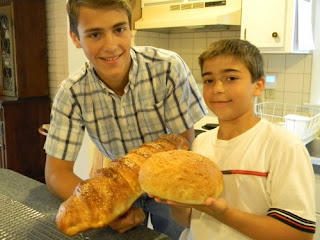
Debbie asked a question in the comments the other week that I thought I'd answer in a post. Maybe more of you readers have had similar questions.
"I have been reading your blog over a year now. Love it so much. I am just curious. I live in East Tennessee and the Mennonite community in this area have no electricity and use horse and buggy for transportation. What is the difference in the different ways of life for a Mennonite? I love your lifestyle and I think this whole Homestead lifestyle has been taken from how the Mennonites live their lives. If you would, sometime in your post would you explain this to those of us who are unfamiliar? I love learning about other lifestyles and people." - Debbie
First, thanks for sticking around so long, Debbie! I didn't know that I had any readers (besides my mom and my husband) that have been reading this blog for a whole year!
I hesitate to use the word "Mennonite" to describe myself. I would much rather be known as a Christian, a Christ-follower and a Child of God then by any particular church denomination name. I chose to include "Mennonite" in my profile description because I often am curious when reading other lady's blogs about their beliefs.
As Debbie alluded, there is a huge difference in various Mennonite churches. Some, like Debbie's neighbors, avoid modern technologies such as electricity and motor vehicles. At the other extreme are Mennonites who are indistinguishable in appearance from the world around them. Obviously, since I'm using a computer, I don't fit in the first group. I'll try to share briefly what we do believe and practice.
I am first of all a Christian and my desire and goal is to follow Christ and the New Testament Scriptures as closely as possible. In many ways, our beliefs, as Mennonites, are similar to other Protestant believers. We believe that the Bible is God's Word and without error (2 Timothy 3:16). We believe that God created a perfect world (Genesis 1:1), that sin entered the world through the choice of Adam and Eve (Romans 5:12), and since then all humans have sinned, including me (Romans 3:23). My sin separates me from God and results in death (Romans 6:23) but God through His love and mercy sent His Son, Jesus Christ to die for my sin (Romans 5:8).
I will highlight a few of the New Testament commands that affect some of the decisions we have made that may set us apart from other Christian churches. Please, in no way take this as judgment against any other Christians, but only an explanation of our choices. None of these things are an attempt to gain us salvation or pardon from our sin. Jesus' death completely fulfilled God's demands. My only goal is to be obedient to God and the Bible out of love for my Lord and Saviour.
Some of our specific beliefs and practices include the following: I wear a covering on my head as a symbol of God's order of headship (1 Corinthians 11:5). Because of Jesus' command to love your enemies (Matthew 5:44), we do not join the armed forces or retaliate in other ways such as going to court. For the purpose of modesty and to not follow the world's idea of fashion (1 Timothy 2:9-10), I wear a cape style dress. While we do have electricity, cars, and computers, we avoid the world's entertainment (Romans 11:2) and do not have television or radio, watch movies, or follow professional sports.
When many people think of Mennonites, they conjure up a picture of a large family working together on a farm and selling baked goods at the end of the lane. Maybe I've contributed to that vision by writing about my chickens, garden, and bread baking. But, in a way, that view of Mennonites makes me sad. The Bible says Christians are to be known for their love for each other, not for their pie baking skills.
Maybe Mennonites have gained the reputation as "homesteaders" because often they have lived in rural areas. With the desire of raising a Godly family, many men wish to work with their families in home businesses. In areas such as Lancaster County, PA and Holmes County, OH the tourism industry has given many families the opportunity to support their family by raising produce and selling baked goods.
But while I believe the country life is a great lifestyle and a wonderful place to raise a family, I also know Godly Mennonite families who are raising their children in city settings. In our congregation, we have only two farmers. Many of the ladies in our church have a garden but some choose not to garden because of location, time or desire. Many of us sew since it is quite difficult to find modest dresses at the shopping mall. But knowing how to can, sew, or grow green beans are not commanded in Scripture and in no way required to be part of our congregation!
Just for a little personal history, I did not grow up in a Mennonite church. My family was part of a Brethren congregation that is in many ways similar to the Mennonites. When I married my husband, we made the decision to make his Mennonite church, our church home. At the time it seemed like a difficult move but almost eight years later, I do not regret the decision.
I hope I've answered some of your questions. I have no interest in starting a debate but please feel free to comment or email me if I have been unclear or if you have more questions. For more information on the web, visit
Anabaptist.org
My desire is that each of us would grow more like the Lord Jesus Christ and that in this small corner of the web you will see the light of Christ.













































